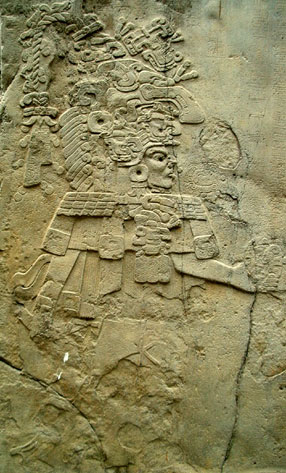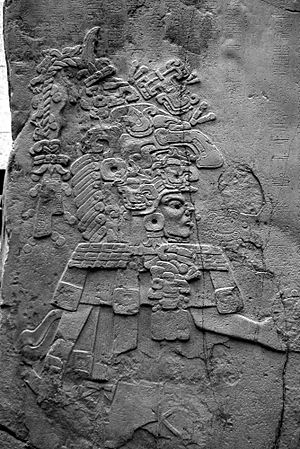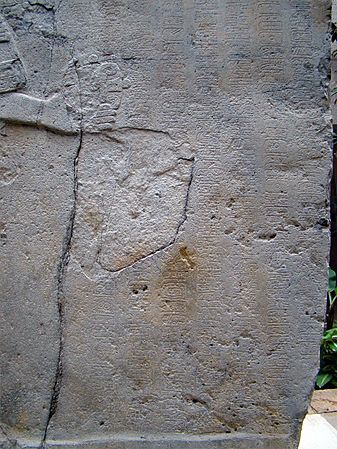La Mojarra Stela 1 facts for kids
Quick facts for kids La Mojarra Stela 1 |
|
|---|---|

Left side image of La Mojarra Stela 1, showing a person identified as "Harvester Mountain Lord".
|
|
| Material | Limestone |
| Created | 2nd century |
| Discovered | 1986 in the Acula River near La Mojarra, Veracruz, Mexico |
| Present location | Museo de Antropología, Xalapa, Veracruz |
La Mojarra Stela 1 is a Mesoamerican carved monument (stela) dating from 156 CE (2nd century CE). It was discovered in 1986, pulled from the Acula River near La Mojarra, Veracruz, Mexico, not far from the Tres Zapotes archaeological site. The 4+1⁄2-foot-wide (1.4 m) by 6+1⁄2-foot-high (2.0 m), four-ton limestone slab contains about 535 glyphs of the Isthmian script. One of Mesoamerica's earliest known written records, this Epi-Olmec culture monument not only recorded this ruler's achievements, but placed them within a cosmological framework of calendars and astronomical events.
The right side of the stone features a full-length portrait of a man in an elaborate headdress and costume, although the bottom half of the carving is very badly weathered. Above the figure, 12 short columns of glyphs have been etched into the stone, matched by eight longer columns to the figure's right. Among these glyphs are two Mesoamerican Long Count calendar dates which correspond to May 143 CE and July 156 CE. The monument is an early example of the type of stela which later became common commemorating rulers of Maya sites in the Classic era.
Discovery and decipherment
For some years after discovery, the monument was in storage in the Museo de Antropología in Xalapa. In November 1995, as the monument was being prepared for display, a previously neglected series of glyphs was noticed on one side in eroded but still partially recognizable condition.
In 1993, and again in 1997, after discovery of the new column of glyphs, John Justeson and Terrence Kaufman put forward a proposed decipherment of the glyphs. This decipherment names the figure depicted as "Harvester Mountain Lord", and describes his ascension to kingship, a solar eclipse, appearances of Venus, warfare, and an attempted usurpation, human sacrifice (perhaps Harvester Mountain Lord's brother-in-law) and Harvester Mountain Lord's own bloodletting.
This decipherment has been disputed by Michael D. Coe and Stephen D. Houston, among others. Resolution of this debate will likely need to await further archaeological discoveries.
See also
 In Spanish: Estela 1 de La Mojarra para niños
In Spanish: Estela 1 de La Mojarra para niños




